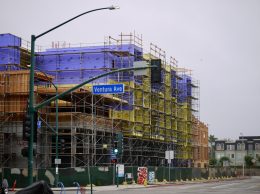Housing conference spotlights worsening market for buyers
IN THIS ARTICLE
- Columns Topic
- Elijah Brumback Author
By Elijah Brumback Friday, April 17th, 2015

Elijah Brumback
The rent is too damn high and so are the home prices.
It isn’t a stretch to think most South Coast residents have this thought at least once a day. With seven out of 10 employees in the region unable to afford a suitable home within a 25 minute commute from their work, the numbers are a sore subject for businesses and city officials alike.
At this year’s annual Santa Barbara Housing Conference, hosted by the Coastal Housing Coalition, affordable housing advocates shook their heads in shame as president of True North Research Timothy McLarney rattled off findings from his firm’s most recent report, South Coast Housing & Its Impacts. The sky-high rents and soaring home values are often referred to as the “price of paradise,” but what good is living in paradise when your days are filled with trying to grind out a living just to keep a roof over your head?
For many young people, those willing to accept 125 square feet and a hot plate as a decent living unit, getting by is workable. After all, this demographic — the sought-after millennial crowd — probably won’t be staying here long, as businesses struggle to offer the salaries and benefits needed to keep top talent. At the conference, a recruiter in the human resources department of footwear company Deckers told the crowd the company is struggling with its attraction efforts. According to McLarney, many businesses in the region reported they “flat-out don’t even try to recruit from outside South Coast, because [employees] won’t come.”
While that last sentence points to just one particular fallout from the housing crisis employers and employees face, the problem is even more systemic, and what’s worse is that there is little being done to combat rising inaccessibility. If you consider for a minute that a person or family with a six-figure income can still be pushed out of the housing market, it’s not hard to understand why this kind of environment is unsustainable.
Nearly half of the almost 3,000 employees who responded in True North’s report said they are seriously considering leaving the South Coast for a more affordable living situation. That number jumps to more than 60 percent among those under the age of 35.
If anecdotal evidence isn’t enough, the numbers paint a better picture. The median household income in Santa Barbara was just over $65,000 between 2009 and 2013, according to the U.S. Census Bureau. In a conservative affordable housing model presented at the conference, those looking for a family home on the South Coast would need to scrape together a down payment of $60,000 and be able to manage a mortgage of around $3,900. That’s impossibly steep for the average family – the median household income, before taxes, was $5,420 a month – and of course, that housing product would first have to exist before anyone could actually buy it.
There are plenty of reasons why the South Coast housing market continues to have such high barriers to entry, and probably always will.
For starters, take a look around. The region’s obvious beauty and uniqueness make it an incredibly popular place to live. Second, there’s the slow growth mentality and aversion to approving developments that dare to even propose more than four stories. On top of that, there’s almost zero incentive for a developer to build a multi-unit affordable housing project when it’s possible to build fewer market-rate units and make a bigger profit.
The list goes on, and the problem is starting to add up in other ways, according to those who spoke at the conference.
A thorn in the side of many cities in the region is vacation rentals. Cities, including Goleta, are trying to make sure visitors who book these rentals are taxed for their stay, but it’s still a tricky prospect to regulate. Detractors of companies like AirBnB say these offerings put hotel workers out of a job and strain the already limited apartment stock. With an apartment vacancy rate of less than 1 percent, renters in Santa Barbara are feeling that pressure.
There are even bigger long-term problems rooted in not having enough affordable housing options. Conference speakers pointed to increased commuter traffic and vehicle emissions, deteriorating quality of life and people disengaged from the communities that they live in.
Some new ideas and tweaks to existing affordable housing models were floated at the conference. More innovative models for employer sponsored housing, community land trusts and new affordable housing funds were among the remedies discussed.
Whatever the way forward might be, it’s clear that the wheels of change turn slowly on this issue. The bright side is that it’s impossible to pretend there isn’t a housing problem.
“We’re all feeling the impacts of this,” McLarney said. “It’s more than just a pinch in the pocketbook. … We’ve been living with this for years.”
• Contact Elijah Brumback at ebrumback@pacbiztimes.com.









